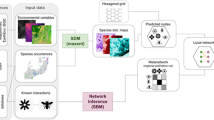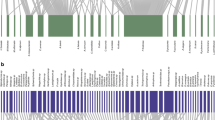Abstract
This study characterizes the structure of a plant–pollinator network in a temperate rain forest of Chiloé Island, southern Chile, where woody species are strongly dependent on biotic pollinators, and analyzes its robustness to the loss of participating species. Degree distribution, nestedness, and expected species persistence were evaluated. In addition, we assessed the roles of predefined subsets of plants (classified by life forms) and pollinators (grouped by taxonomic orders) in the network’s structure and dynamics. For this, we simulated the complete removal of each plant and pollinator subset and analyzed the resultant connectivity patterns, as well as the expected long-term species losses by running a stochastic model. Finally, we evaluated the sensitivity of the network structure to the loss of single species in order to identify potential targets for conservation. Our results show that the plant–pollinator network of this Chilean temperate rain forest exhibits a nested structure of interactions, with a degree distribution best described by a power law model. Model simulations revealed the importance of trees and hymenopterans as pivotal groups that maintain the core structure of the pollination network and guarantee overall species persistence. The hymenopterans Bombus dahlbomii and Diphaglossa gayi, the shrubs Tepualia stipularis and Ugni molinae, the vines Mitraria coccinea and Asteranthera ovata, and the entire set of tree species exerted a disproportionately large influence on the preservation of network structure and should be considered as focal species for conservation programs given current threats from selective logging and habitat loss.





Similar content being viewed by others
References
Aizen MA, Ezcurra C (1998) High incidence of plant-animal mutualisms in the woody flora of the temperate forest of southern South America: biogeographical origin and present ecological significance. Ecol Aust (Argentina) 8:217–236
Aizen MA, Vasquez DP, Smith-Ramírez C (2002) Historia natural y conservación de los mutualismos planta-animal del bosque templado de Sudamérica austral. Rev Chil Hist Nat 75:79–97
Albert R, Barabási A-L (2002) Statistical mechanics of complex networks. Rev Mod Phys 74:47–97
Albert R, Jeong H, Barabási A-L (2000) Error and attack tolerance of complex networks. Nature 406:378–382
Amaral LA, Scala A, Barthélémy M, Stanley HE (2000) Classes of small-world networks. PNAS 97:11149–11152
Aravena JC, Carmona M, Perez C, Armesto JJ (2002) Changes in tree species richness, stand structure and soil properties in a successional chronosequence in northern Chiloé Island. Chile Rev Chil Hist Nat 75:339–360
Armesto JJ, Rozzi R (1989) Seed dispersal syndromes in the rain forest of Chiloé: evidence for the importance of biotic dispersal in a temperate rain forest. J Biogeogr 16:219–226
Armesto JJ, Smith-Ramírez C, Sabag C (1996) The importance of plant-bird mutualism in the temperate rainforest of southern South America. In: Lawford RG, Alaback PB, Fuentes E (eds) High latitude rain forests and associated ecosystems of the west coast of the Americas: climate, hydrology, ecology and conservation. Springer, Berlin, pp 248–265
Arroyo MTK, Hoffman AE (1997) Temperate rain forest of Chile. In: Davis SD, Herrera-MacBryde O, Villa-Lobos J, Hamilton AC (eds) Centres of plant diversity, vol 3. The Americas. World Wildlife Fund and International Union for Conservation of Nature, New York, pp 542–548
Atmar W, Patterson BD (1993) The measure of order and disorder in the distribution of species in fragmented habitat. Oecologia 96:373–382
Bascompte J, Jordano P (2007) Plant-animal mutualistic networks: the architecture of biodiversity. Annu Rev Ecol Evol Syst 38:567–593
Bascompte J, Jordano P, Melian CJ, Olesen JM (2003) The nested assembly of plant–animal mutualistic networks. PNAS 100:9383–9387
Bascompte J, Jordano P, Olesen JM (2006) Asymmetric coevolutionary networks facilitate biodiversity maintenance. Science 312:431–433
Burnham KP, Anderson DR (2004) Multimodel inference: understanding AIC and BIC in model selection. Soc Meth Res 33:261–304
Díaz IA, Armesto JJ, Reid S, Sieving KE, Willson MF (2005) Linking forest structure and composition: avian diversity in successional forests of Chiloé Island. Chile Biol Conserv 123:91–101
Dinerstein E, Olson DM, Graham DJ, Webster AL, Primm SA, Bookinder MP, Ledec G (1995) Una evaluación del estado de conservación de las ecorregiones terrestres de América Latina y el Caribe. Banco Mundial, World Wildlife Fund
Dunne JA, Williams RJ, Martínez ND (2002a) Food-web structure and network theory: the role of connectance and size. PNAS 99:2917–12922
Dunne JA, Williams RJ, Martínez ND (2002b) Network structure and biodiversity loss in food webs: robustness increases with connectance. Ecol Lett 5:558–567
Figueroa J, Armesto JJ, Hernández JF (1996) Estrategias de germinación y latencia de semillas en especies del bosque templado de Chiloé. Chile Rev Chil Hist Nat 69:243–251
Fortuna MA, Bascompte J (2006) Habitat loss and the structure of plant–animal mutualistic networks. Ecol Lett 9:281–286
Guimarães PR, Guimarães P (2006) Improving the analyses of nestedness for large sets of matrices. Environ Modell Softw 21:1512–1513
Heywood VH (1995) Global biodiversity assessment. Cambridge University Press, Cambridge
Jordano P (1987) Patterns of mutualistic interactions in pollination and seed dispersal: connectance, dependence asymmetries, and coevolution. Am Nat 129:657–677
Jordano P, Bascompte J, Olesen JM (2003) Invariant properties in coevolutionary networks of plant–animal interactions. Ecol Lett 6:69–81
Marquet PA, Fernández M, Navarrete SA, Valdovinos C (2004) Diversity emerging: toward a deconstruction of biodiversity patterns. In: Lomolino M, Heaney LR (eds) Frontiers of biogeography: new directions in the geography of nature. Sinauer Associates, Massachusetts, pp 191–209
Martinez ND (1992) Constant connectance in community food webs. Am Nat 139:1208–1218
Memmott J (1999) The structure of a plant–pollinator food web. Ecol Lett 2:276–280
Memmott J, Waser NM, Price MV (2004) Tolerance of pollination networks to species extinctions. Proc R Soc B Biol Sci 271:2605–2611
Montoya JM, Solé RV (2003) Topological properties of food webs: from real data to community assembly models. Oikos 102:614–622
Myers N, Mittermeier RA, da Fonseca GAB, Kent J (2000) Biodiversity hotspots for conservation priorities. Nature 403:853–858
Newman MEJ (2003) The structure and function of complex networks. SIAM Rev 45:167–256
Newman MEJ (2005) Power laws, Pareto distributions and Zipf’s law. Contemp Phys 46:323–351
Newton A (2007) Biodiversity loss and conservation in fragmented forest landscapes: evidence from Mexican montane forests and the temperate rainforests of South America. CABI, UK
Pascual M, Dunne JA (2006) Ecological networks: linking structure to dynamics in food webs. Oxford University Press, UK
Riveros M, Humaña AM, Lanfranco D (1991) Actividad de los polinizadores en el Parque Nacional Puyehue, X Región, Chile. Medio Ambiente (Chile) 11:5–12
Rodríguez-Gironés MA, Santamaría L (2006) A new algorithm to calculate the nestedness temperature of presence–absence matrices. J Biogeogr 33:924–935
Santamaría L, Rodríguez-Gironés MA (2007) Linkage rules for plant–pollinator networks: trait complementarity or exploitation barriers? PLoS Biol 5:e31. doi:10.1371/journal.pbio.0050031
Smith-Ramírez C, Armesto JJ (1994) Flowering and fruiting patterns in the temperate rainforest of Chiloé, Chile—ecologies and climatic contraints. J Ecol 82:353–365
Smith-Ramírez C, Martínez P, Nuñez M, González C, Armesto JJ (2005) Diversity, flower visitation frequency, and generalism of pollinators in temperate rain forests of Chiloe island. Chile Bot J Linn Soc 147:399–416
Strogatz SH (2001) Exploring complex networks. Nature 410:268–276
Valdovinos FS, Ramos-Jiliberto R, Flores JD, Espinoza C, López G (2009) Structure and dynamics of pollination networks: the role of alien plants. Oikos (in press). doi:10.1111/j.1600-0706.2009.17364.x
Vázquez DP (2005) Degree distribution in plant–animal mutualistic networks: forbidden links or random interactions? Oikos 108:421–426
Vázquez DP, Aizen MA (2004) Asymmetric specialization: a pervasive feature of plant–pollinator interactions. Ecology 85:1251–1257
Williams RJ, Martinez ND (2000) Simple rules yield complex food webs. Nature 404:180–183
Acknowledgements
The authors thank J. D. Flores for his valuable help in scientific computing, M. A. Fortuna for his help with the dynamic model, M. A. Rodríguez-Gironés for specially implementing a batch version of his software BINMATNEST, and M. Franco for improving the readability of this paper. All the experiments and sampling comply with the current laws of the country (Chile) in which they were performed. Work started by an Endowed Presidential Chair in Sciences to J. J. A. We acknowledge support from FONDAP–FONDECYT 1501-0001, P05-002 ICM and PFB-23 CONICYT, Chile. This is a contribution to the research program of Senda Darwin Biological Station, Chiloé, Chile. We appreciate the company and assistance in the field of M. Nuñez-Ávila, L. Suárez, P. Martínez and el Negro.
Author information
Authors and Affiliations
Corresponding author
Additional information
Communicated by Miguel Franco.
Rights and permissions
About this article
Cite this article
Ramos-Jiliberto, R., Albornoz, A.A., Valdovinos, F.S. et al. A network analysis of plant–pollinator interactions in temperate rain forests of Chiloé Island, Chile. Oecologia 160, 697–706 (2009). https://doi.org/10.1007/s00442-009-1344-7
Received:
Accepted:
Published:
Issue Date:
DOI: https://doi.org/10.1007/s00442-009-1344-7




